The Muromachi Period
Emperor Go-Daigo and Ashikaga Takauji (1)Emperor Go-Daigo (後醍醐天皇, 1288-1339) eventually restored imperial rule in 1333 by taking advantage of the power of the dissatisfied warriors. This movement is called Kemmu no Chuko (建武中興), the Kemmu Restoration, as the Emperor changed the era name to Kemmu (建武), a reign that lasted only two and half years, from 1333 to 1336. Among these dissatisfied warriors was Ashikaga Takauji (足利高氏, later written 尊氏, 1305-58).
In Kamakura, Ashikaga Tadayoshi (足利直義, 1306-52), a younger brother of Takauji, seized actual power as Sagami no Kami (相模守), head of Sagami Province (相模国), under Prince Nariyoshi (成良親王, 1326-44, alternatively called Narinaga). The stable conditions that Emperor Go-Daigo had expected did not last long.
Eager to regain control of the country, he had to reward his supporters, particularly in regard to the courtiers. Initially, Takauji placed priority on rule by the emperor, but his brother, Tadayoshi, sought for ways in which they could establish their own rule.
To complicate matters more, Go-Daigo's son, Prince Morinaga (護良親王, 1308-35, alternatively called Moriyoshi) was opposed to Takauji, and in 1334 made an abortive attempt to do away with him. Angered, Takauji forced the emperor to arrest the prince, then had him sent to Kamakura to be placed in the custody of Tadayoshi.
Tragic death of Prince Morinaga
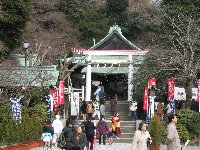
|
| Kamakuragu Shrine |
Five hundred years later, when Emperor Meiji (明治天皇, 1852-1912) learned of this story, he decided to build a shrine dedicated to Prince Morinaga, and named it Kamakuragu (鎌倉宮).
Emperor Go-Daigo and Ashikaga Takauji (2)
After Tadayoshi was routed from Kamakura, the Hojo temporarily occupied the city. Upon learning of this, Takauji urged the emperor to appoint him seii-tai- shogun, a title he had eagerly desired, as it would authorize his actions. But his hopes were shattered when the emperor instead appointed Prince Nariyoshi, who was only four years old.
Without the emperor's permission, Takauji then set out from Kyoto and, together with Tadayoshi, who had joined him in Mikawa, defeated the Hojo and forced them out of Kamakura. Takauji and Tadayoshi stayed in Kamakura.
Afterwards, the emperor requested Takauji to return to Kyoto, which he was willing to do because he was ready to reconcile with the imperial court. Tadayoshi, however, was reluctant, and in the end persuaded Takauji to reject the emperor's request. (Such differences between the two brothers gradually multiplied, leading to confrontations that culminated in the still-unsolved death of Tadayoshi 17 years later in 1352.)
Offended by the refusal to return to Kyoto, the emperor dispatched Nitta Yoshisada (新田義貞, 1301-38) to subdue the two brothers. Yoshisada, however, contrary to the emperor's expectations, was defeated. In the midst of these events, Takauji at one point temporarily confined himself inside Jokomyoji Temple (浄光明寺) in Ogigayatsu (扇ケ谷) to express his obedience to the emperor.
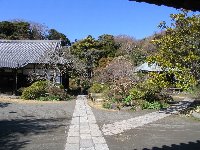
|
| Jokomyoji Temple |
Northern and Southern courts
Ashikaga Takauji, however, got support from warriors who were dissatisfied with the emperor's new rule. Again, he rose against the emperor, gaining a string of victories along the way as he approached Kyoto. Takauji then appointed another emperor, Komyo (光明天皇, 1321-80), and emperor Go-Daigo moved to Yoshino and, until his death in 1339, firmly maintained a claim to the legitimacy of his Yoshino government.
Thus, from 1336, two family lines vied within the imperial family: the Ashikaga-backed Northern Court, Hokucho (北朝) of Emperor Komyo and his successors in Kyoto, and the Southern Court, Nancho (南朝) of Emperor Go-Daigo and his successors at Yoshino.
This was the beginning of the Nambokucho Period (1336-92), the period of the Northern and Southern Courts. The army of the Southern Court gradually lost ground.
In 1336, Takauji promulgated the Kemmu Shikimoku (建武式目), the Kemmu Code, which stated the basic principles and policies of governance. These included the maintenance of law and order, respect for property rights, selection and reward of officials based on merit, attention to the complaints of the poor, and the necessity of thrift. The code signified the virtual start of the Muromachi bakufu (室町幕府) in Kyoto.
In 1338, Takauji received the title, Seii Tai Shogun, from the Northern Court, making him the first shogun of the Muromachi bakufu, which was to last for some 230 years. Meanwhile, Emperor Go-Daigo, still indignant towards his rival, died at Mt. Yoshino (吉野山) in 1339.
Ashikaga Takauji and his sons
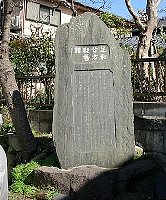
|
|
Former site of Kamakura Kubo residence |
Later, Yoshiakira became the second shogun of the Muromachi bakufu, succeeding Takauji in 1358. Kamakura-fu was also called Kamakura Gosho (鎌倉御所) Motouji controlled the present-day Kanto region plus the two outer-Kanto Provinces of Izu (伊豆国) and Kai (甲斐国).
The country, however, did not become peaceful. The rivalry between the supporters of the Southern and Northern courts continued, as did the conflicts between the two brothers, Takauji and Tadayoshi, and the struggles between Tadayoshi and an influential retainer, Ko no Moronao (高師直, ?-1351).
As a result of these power struggles, Tadayoshi was forced to leave Kyoto, and later formed an army and even fought against his brother, Takauji. To subdue Tadayoshi, Takauji set out from Kyoto and, in 1352, entered Kamakura with Tadayoshi as his prisoner. Soon after, Tadayoshi died in mysterious circumstances.
Takauji's efforts notwithstanding, unstable conditions continued. After a certain period of time, Takauji again returned to Kyoto, where his eventful life came to an end in 1358. His second son, Yoshiakira, then became the second shogun in Kyoto in that same year.
Uesugi family, shogunal deputies for the Kanto Region
In 1363, Takauji's third son, Motouji, in charge at Kamakura-fu, invited Uesugi Noriaki (上杉憲顕, 1306-68) from Echigo (越後, present-day Niigata Prefecture, 新潟県) to support him as Kanto kanrei (関東管令), shogunal deputy for the Kanto region. From that time on, members of the Uesugi family succeeded to this position for generations, and played important roles in and around Kamakura.
The origin of the Uesugi family in Kanto dates back to the mid-Kamakura period when Uesugi Shigefusa (上杉重房) in Kyoto came to Kamakura attending on Prince Munetaka (宗尊親王, 1242-74), who, in 1252 was to become the sixth shogun of the Kamakura shogunate. Shigefusa's granddaughter was the mother of Takauji, and his great-grandson was the above-mentioned Noriaki, who became the founder of the Yamanouchi Uesugi (山ノ内上杉). So successful was Noriaki's term of administration that an interval of peace and tranquility finally came to Kamakura.
Second Kamakura kubo Ashikaga Ujimitsu's ambition
Peace lasted through the reign of Motouji, the first Kamakura kubo, who died at the age of 28 in 1367, and was succeeded by Ujimitsu (氏満, 1359-98) in 1369. Then began an unstable relationship between successive kubo and the Uesugi. In addition, conflicts arose between Kamakura and Kyoto.
In Kyoto, Ashikaga Yoshimitsu (足利義満, 1358-1408) became the third shogun in 1368; in retrospect the most powerful among the sixteen shoguns of the Muromachi bakufu. Nevertheless, it must be kept in mind that he was only ten years old when he became shogun and was under the guidance of Hosokawa Yoriyuki (細川頼之, 1329-92). Because Yoriyuki was overly zealous in attempting to strengthen the authority of the shogun, his opponents spread rumors of his despotism. This, in turn, tempted Ujimitsu in Kamakura to seek the position of shogun in Kyoto when he became 20 years old. Opposed to this was kanrei Uesugi Noriharu (上杉憲春, ?-1379), who expressed his objection by killing himself, whereupon Ujimitsu gave up his intention of confronting the Muromachi shogunate
Muromachi bakufu at its height under Ashikaga Yoshimitsu
In Kyoto, Yoshimitsu ended the rivalry between the Southern and Northern courts in 1392. He built a magnificent residence in Muromachi, the eastern part of the city; hence the name, Muromachi bakufu. During his reign, Yoshimitsu completed the ranking system for temples called Gozan, "Five Mountains."
The Kyoto Gozan consisted of Tenryuji (天龍寺), Shokokuji (相国寺), Kenninji (建仁寺), Tofukuji (東福寺), and Manjuji (満寿寺), with Nanzenji (南禅寺) presiding as the head temple.
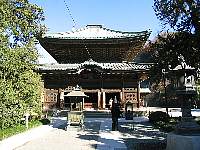
|
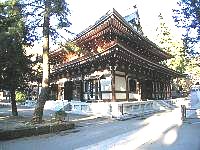
|
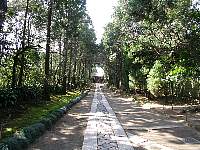
|
| Kenchoji Temple | Engakuji Temple | Jufukuji Temple |
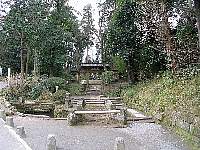
|
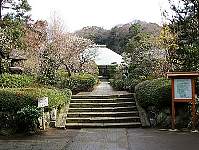
|
| Jochiji Temple | Jomyoji Temple |
The Kamakura Gozan (鎌倉五山) included Kenchoji (建長寺), Engakuji (円覚寺), Jufukuji (寿福寺), Jochiji (浄智寺), and Jomyoji (浄明寺). In due time the Gozan system produced a Chinese style of literature called Gozan Bungaku (五山文学), "Five Mountain Literature." Yoshimitsu is also known as the founder of Kinkakuji Temple (金閣寺), built in 1408.
Ashikaga Mitsukame, the third Kamakura kubo, tries to take action against the Kyoto government
In Kamakura, in 1398, Mitsukane (満兼, 1378-1409) succeeded to the position of kubo upon the death of Ujimitsu. The next year, having decided to attempt to topple the shogunate in Kyoto, he left Kamakura with his forces, but after learning of the defeat of his ally, Ouchi Yoshihiro (大内義弘, 1356-99) in Kyoto, he gave up before reaching Mt. Hakone (箱根山) and returned to Kamakura.
Commercial activities in Kamakura
In spite of all of these conflicts and battles, Kamakura thrived as the central city in the eastern part of Japan. There were warrior residences around the kubo's mansion in Jomyoji, and other parts of the city contained dense concentrations of houses, shops and workshops run by merchants and craftsmen under the za (座) system.
In general, the za, (trade or craft organizations of merchants, artisans, and others) were quite active during the Muromachi period throughout the country. Under the protection of patrons such as shoguns, daimyo (大名, feudal lords), Kyoto courtiers, temples, and shrines, these guilds formed monopolies which protected them from outside competition.
In Kamakura, there were seven major za, called Kamakura shichiza (鎌倉七座). These included za for silk, charcoal, rice, cooking utensils made of cypress bark, firewood, semi-dried fish and other seafood, and horse trading. In addition, there were za for lumber, salt, copper, oil, umbrellas, sake, and a type of dried thin wheat noodle.
Conflict between Kamakura kubo and Kanto kanrei
The position of Kamakura kubo was held by Motouji (基氏), Ujimitsu (氏満), Mitsukane (満兼) (as have been mentioned), and Mochiuji (持氏, 1398-1439). The post of Kanto Kanrei throughout those years was successively held by family members of the Uesugi.
They had four branches: Inukake (犬懸), Takuma (宅間), Yamanouchi (山ノ内) and Ogigayatsu (扇ケ谷). It was these four families that held the position of Kanto kanrei in turn, although at times they were at odds trying to secure the position for their own family.
When Mochiuji was the fourth kubo, Uesugi Ujinori (上杉氏憲, ?-1417), also called Zenshu (禅秀), of the Inukake branch of the Uesugi, rose against the Kamakura Kubo in 1416. Zenshu had once served as kanrei but resigned in 1415 to protest Mochiuji's undue favoritism towards the Yamanouchi Uesugi. In the battle that followed in 1416, Zenshu initially succeeded in driving Mochiuji from Kamakura but was soon defeated by the shogunal army, and in 1417 committed suicide. The affair is referred to as the Uesugi Zenshu no Ran (上杉禅秀の乱), the rebellion of Uesugi Zenshu.
The Muromachi bakufu under the fourth shogun, Ashikaga Yoshimochi (足利義持, 1386-1428), aided the Kamakura kubo while the rebellion was in progress, but in the years that followed, the two were again at odds.
On several occasions, Ashikaga Mochiuji in Kamakura took action in defiance of the shogun in Kyoto. Then, in 1422 he started to maneuver his army in order to subdue the warriors whose loyalty he had started to question. Some, in fact, were actually being supported by the Muromachi bakufu who wanted to keep a watch on Mochiuji himself. Consequently, Mochiuji's maneuvering was seen as a direct challenge to the authority of the shogunate. To avoid a confrontation, he sent a mission to Kyoto bearing an apology for his reckless action.
Ashikaga Mochiuji, the fourth Kamakura kubo, who took action against the Kyoto government
After Yoshimochi retired, Ashikaga Yoshikazu (足利義量, 1407-25) became the fifth shogun, but died at the tender age of seventeen, having reigned for only two years. Unfortunately, the retired Yoshimochi died three years later, in 1428, without having made any provisions regarding an heir, for he had known he was powerless without support from the influential feudal lords.
Surprisingly, the decision about who should be the sixth shogun was made by drawing lots. Among the four eligible brothers, Yoshinori (義教, 1394-1441), who was already been in the priesthood, won the draw. For Mochiuji in Kamakura, the decision came as a surprise, as he had expected that he himself would become the sixth shogun upon the death of the fifth.
When his antagonism toward Yoshinori eventually came to a head, Uesugi Norizane (上杉憲実, 1410-66) in Kamakura tried to mediate between the two but succeeded only in incurring Mochiuji's distrust and had to seek refuge in Kozuke in 1438. Mochiuji led his army in pursuit of Norizane, but was intercepted by the shogunal forces, captured, and eventually forced to commit suicide at Yoanji Temple (永安寺, now abolished, but located next to Zuisenji Temple, 瑞泉寺) in 1439.
Mochiuji's son, Yoshihisa (義久), at the age of ten (some say fourteen) was also involved in this incident, and killed himself at Hokokuji Temple (報国寺). This rebellion is referred to as the Eikyo no Ran (永享の乱), the Eikyo rebellion.
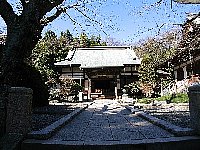
|
| Hokokuji Temple |
Kamakura in chaos
After the Eikyo Rebellion, the Kanto region was again thrown into chaos. In 1439, Shogun Yoshinori in Kyoto sent his son to Kamakura as kubo. Unable to become one formally, he stayed at the Utsunomiya-zushi (near Ni no Torii, ニの鳥居) subsequently came to be referred to as Utsunomiya Kubo (宇都宮公方).
Battles ensued and continued between the two factions: one being Utsunomiya kubo, backed by Uesugi Norizane, and the other, Mochiuji's sons, An'omaru (安王丸) and Haruomaru (春王丸) and their supporters. Eventually, An'omaru and Haruomaru were captured and killed while being taken to Kyoto in 1441. Another Mochiuji son, Eijuomaru (永寿王丸) was saved.
Later, in 1449, after being pardoned and named Ashikaga Shigeuji (足利成氏, 1438-97), Eijuomaru was dispatched to Kamakura as Kanto kubo. Because his hostility towards the Uesugi had never abated, in 1454 he slew Norizane's son, Uesugi Noritada (上杉憲忠, 1433-54), in revenge.
As a result, Shigeuji was attacked by the shogunal army. He fled to Koga (古河, in present-day Ibaraki Prefecture, 茨城県) and set up defenses there. He then came to be referred to as the Koga kubo (古河公坊), a post that was weakly maintained by his four descendants until 1583.
In 1457, the eighth shogun, Ashikaga Yoshimasa (足利義政, 1436-90) in Kyoto sent the army of his younger brother, Ashikaga Masatomo (足利政知, 1435-91), to bring the Koga kubo under shogunal control.
Unable to claim victory or even to enter Kamakura, Masatomo had to set up his base in Horikoshi (堀越) on the Izu Peninsula (伊豆半島), and subsequently was called Horikoshi kubo (堀越公坊). With real power being held by the Yamanouchi Uesugi, Horikoshi was powerless.
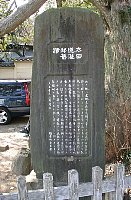
|
| Former site of Dokan residence |
The latter had extended its power through the assistance of Ota Dokan (太田道灌, 1432-86), a warrior who had built the original Edo Castle (江戸城) to defend himself against the Koga kubo. Year after year battles among the Uesugi sub-families continued, and with the passage of time Kamakura declined, losing its political role in eastern Japan.
Kamakura in the Sengoku period
(Warring States period: This section includes the years between 1467 and 1603)
In the early Sengoku period, Kamakura was under the control of the Miura family. Around that time, a military leader Hojo Soun (北条早雲, 1432-1519) emerged from the Izu area and captured Odawara Castle (小田原城) in 1494.This Hojo family, unconnected with the Hojo of the Kamakura period, was called Go-Hojo (後北條), the later Hojo. Hojo Soun forcefully extended his domain. He defeated the Miura family at Sumiyoshi Castle (住吉城), driving them from Kamakura and eventually destroying them at Arai Castle (新井城) in Miura. With this, Kamakura came under the control of the Go-Hojo.
Hojo Soun built Tamanawa Castle (玉縄城), and the Go-Hojo family then used it as a key point from which to guard the pathways to the Miura Peninsula and the Musashi district.
From the time of its founding, the castle was reputed to be impregnable and in 1526 witnessed the struggle between Hojo Ujitsuna (氏綱, 1486-1541), its defender, and the Satomi (里見) from Awa (安房), who had invaded Kamakura. An intense battle was fought near the Kashiogawa River (柏尾川, present-day Tobegawa, 戸部川) and 35 lives were lost.
A crypt for their heads and the repose of their souls--Tamanawa Kubizuka Mound (玉縄首塚)--was then built near Tobebashi Bridge (戸部橋).
Influential warriors' sojourn in Kamakura
Though Kamakura became less prosperous, it remained an attractive place for warriors in this period, for they wished to share the good fortune and power of Yoritomo and to gain protection from his tutelary deity, Hachiman.Some of the leading warriors of the day paid visits to Kamakura. Among them was Uesugi Kenshin (上杉謙信, 1530-78), an influential daimyo in Echigo (越後, present-day Niigata Prefecture, 新潟県).
Another warrior who visited Kamakura was Toyotomi Hideyoshi (豊臣秀吉, 1537-98), the second ruler (after Oda Nobunaga, 織田信長, 1534-82) of a unified Japan. Hideyoshi visited here after he conquered the Go-Hojo and most of the Kanto region in 1590. Tamanawa Castle, under Hojo Ujikatsu (北条氏勝, 1559-1611) also surrendered to him.
Hideyoshi presented the former lands of the Go-Hojo to Tokugawa Ieyasu (徳川家康, 1542-1616), and while visiting here, ordered Ieyasu to repair Hachimangu Shrine (鶴が丘八幡宮). The heroes of the Warring States period had high esteem for Yoritomo and his political achievements.